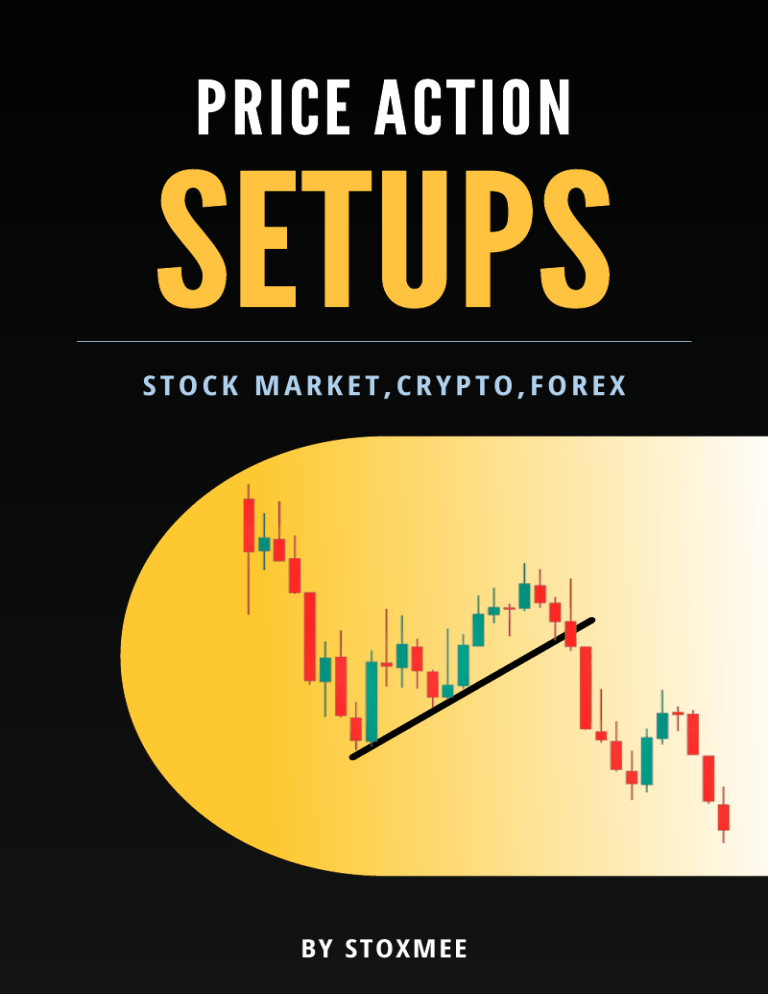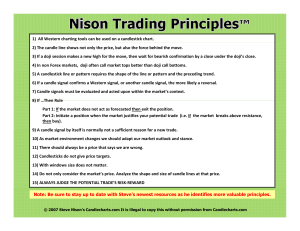
PRICE ACTION SETUPS STOCK MARKET,CRYPTO,FOREX BY STOXMEE INTRODUCTION hello Friends In This Ebook you Get Top Price action Setup For Treadig And you can use it in stock market forex crypto, you have to understand it well and learn All Price Action Setup In 15 Minutes Time Frame PRESENT BY STOXMEE 03 PRICE ACTION SETUPS 1 15 MINUTES Selling Trap Bullish channel Don't Sell Here Price moves up in a bullish channel 04 Buying Opportunity We have to buy as soon as the candle closes above the trend line Target Entry Stoploss 05 PRICE ACTION SETUPS 2 Price moving in a box Here we have to wait the conformation Buying Opportunity Here we found a higher high pattern so we can enter here with a small stoploss 06 Higher High Higher Low We have to enter as soon as the previous high break Target Entry Stoploss 07 PRICE ACTION SETUPS 3 Don't Buy And Sell On This Level Wait For Touch This Support Level Here came a good moment after a resistance break, now we can re-enter here, but after the price approaches the support line Whenever the price take support at a level, we should enter after a bullish confirmation. Support bullish engulfing pattern 08 Trend Change Because Higher High Patten Lower High Lower Low Higher Low We have to buy on support only when there is bullish engulfing and higher high pattern. Target Entry Stoploss PRICE ACTION SETUPS 4 09 Friends, never a stock goes down in one go, it is known to everyone when the stock is in a down trend, then such patterns are seen, so here we have to go to the sell side not the buy side. Whenever the stock is in a down trend you see such a pattern that means it is moving up by touching a neckline, then it is to use the RSI indicator to wait the neckline to break. Price Going Up RSI Value Going Down 10 Price Going Up RSI Value Going Down 11 When the neckline break, we have to enter trade Selling Opportunity 12 Stoploss Entry Target Target Level Here the target is to set the previous low PRICE ACTION SETUPS 5 Here all the traders wait for the breakout and as soon as the breakout comes, here all the traders buy and those traders are trap 13 14 Traders are often trapped in this type of breakout, here we should find the opportunity of selling rather than buying. RSI Value Going Down 15 16 So here I had to explain to you that in this type of pattern we are trapped, we often have to keep this in mind in trading. PRICE ACTION SETUPS 6 17 Creating Double Top Pattern Whenever this kind of pattern is formed, we should look for selling opportunity. This type of neckline has to be made in this type of pattern and the wait is to break. Selling Opportunity Selling Opportunity 18 Stoploss Entry Target You have to enter as soon as the level break Stoploss Entry Target PRICE ACTION SETUPS 7 19 Selling Trap 20 21 Buying Opportunity Target Entry Stoploss PRICE ACTION SETUPS 8 22 Morning 1st 15M Candle You can use this strategy in nifty and banknifty and in stocks Here you have to mark the high and low of the candle for the first 15 minutes And here we have to wait for the marked level to break 23 morning 1st 15 minute low break Selling Opportunity 24 Stoploss Entry Target Level Stoploss Entry Target Target PRICE ACTION SETUPS 9 25 demand zone Selling Trap demand zone 26 Target Leval Buying Opportunity Target Entry Stoploss PRICE ACTION SETUPS 10 27 Inverse Head And Shoulders 28 Buying Opportunity Target 2 Target 1 Entry Stoploss For Target 1 Stoploss For Target 2 29 Target Entry Stoploss PRICE ACTION SETUPS 11 30 Don't buy and Sell Here Wait for Confirmation Wait for Retest Buying confirmation will be found when the price closes above the trend line 31 Buying Opportunity Target Entry Stoploss 32 Target Target Re enter Entry Stoploss Support Level Stoploss PRICE ACTION SETUPS 12 33 After a big momentum we see patterns like this We don't have to buy into the breakout immediately Don't Buy here 34 Often in this type of breakout, we see a double top. we have to go to the selling side here Selling Opportunity 35 Stoploss Entry Target PRICE ACTION SETUPS 13 36 Symmetrical Triangle Pattern In this type of pattern, the price often goes up not down. 37 Level Not Break Don't Sell here next Day opening 38 Buying Opportunity Target Level Entry Stoploss PRICE ACTION SETUPS 14 39 lower High lower High higher High Higher low lower low Higher High lower High lower High lower low Buying Opportunity Higher low Higher low 40 Target Level Entry Stoploss Creating Double Bottom 41 Buying Opportunity After Breakout buy here Target Level Entry Stoploss PRICE ACTION SETUPS 15 42 Buying Opportunity 43 Target Level Entry Stoploss PRICE ACTION SETUPS 16 44 45 Buying Opportunity Target Entry Stoploss PRICE ACTION SETUPS 17 46 47 Bearish Engulfing Selling Opportunity 48 Stoploss Entry Target PRICE ACTION SETUPS 18 49 Buying Opportunity 50 Target Entry Stoploss PRICE ACTION SETUPS 19 51 Buying Opportunity 52 Target Entry Stoploss 53 Buy Here Sell Here 54 Buy Here Sell Here Buy Here 55 Sell Here Sell Here 56 Sell Here 57 Buy Here Buy Here 58 Sell Here 59 IMPORTANT FOR PRICE ACTION Candlestick Chart The concept of candlestick charts came from Japan. That is why they are often referred to as Japanese candlestick charts. These charts are the most versatile and popular form of chart representation. Price behavior during each time unit is represented in the form of a candle. If the closing price of a stock is higher than open price during a particular time period, then the candle is green, if the close price is below the open price then the candle is red. Each candle has a body and two wicks. The distance between open to close is represented by the body of a candle and the upper and lower wicks represent the highs and lows of a candle. highest price highest price closing price OPENING price OPENING price OPENING price LOWEST price LOWEST price 60 Candlestick chart is special not only because it adds a special visual clarity about the price action, but also because often a single candle stick or two or three consecutive candlesticks together form a pattern that indicate reversal of a prior move or give conviction on continuation of the ongoing move. These are called candlestick patterns. We will discuss about them in due course of time Candlestick Chart Pattern Example 61 Trends Market Trend and Range-Bound Consolidation Often market movements happen in the form of trends. A price trend is a continuous or a directional price movement in upward or downward direction. We call them up trend and down -trend respectively. Now if we look at price action in market through charts, we will find that no price movement happens in a straight line. Suppose we are looking at a broader uptrend represented as primary move, we may find intermediate corrections represented as secondary trend and minor counter moves among the secondary moves represented as minor trend. This is how the market behaves generally in both the up and the down trends Market Trends primary Trend Often an up- trend is represented in the form of a sequence of higher highs and higher lows. Similarly a downtrend is represented as a sequence of lower lows and lower highs. A trend is said to reverse when the sequence is broken. 62 Trend Reversal lower high- up trend over up trend higher highs and higher lows down trend lower highs and lower lows higher low- down trend over We should remember a simple point that market is not trending all the time. Often the market consolidates within a small range and goes nowhere. Then suddenly it can break on the upside or downside. Market Consolidation do w n tr en d consolidation d en tr up 63 Trendline and Channels are one of the most simple and useful tools in the market. During an uptrend, a trendline is formed by joining lowest points of periodic pull-backs, defined as secondary moves in the previous section. The uptrend line has positive slope. To be precise we need two lows to join to form a trendline during an up-move. This line is then extended in the upward direction; the third move towards the trend-line is used to validate the trend line. If the trend line is not broken in the pull back, then it is called trend-line validation. It is often observed that price pulls back towards the trend line and moves higher. In an uptrending market it is often easier to make money if one buys near the trend line and sells higher. The more number of time the trend-line is validated, more important it becomes. An upward trend line is said to be the area of support. The selling pressure meets the buying pressure here and eventually overtime when buying pressure is higher than selling pressure price sees an upward bounce. up trend buying opportunities stoploss Now when one buys he or she is looking for the prices to move higher. But this may or may not happen. Hence the investor should maintain a stop loss point below which he-or she should cut his position, i.e. book loss. When a trend line is broken, either the market may reverse the trend, continue the uptrend with little less force or just go sideways 64 Uptrend Reversal trend reversal sideways moments trend reversal trend reversal Similarly, during a down-trend: a trendline is formed by joining pull-back highs. They slope downwards. Just like an up-trend line a down-trend line is formed by joining two points and then extended in downward direction. Pull backs towards the trend-lines are low risk points for short selling with a stop loss little above the trend line. More number of times the line is validated, more it grows in importance. Downtrend hl Similar to an uptrend-line, when a down trending trend line is broken the trend may continue with less pace, or reverse or may go side-ways. A downward trend line is said to be area of resistance. The selling pressure meets the buying pressure here and eventually overtime when selling pressure is higher than buying pressure price sees a decline. 65 Triangles Triangles are one of the most well-known chart patterns used in technical analysis. The three most common types of triangles, which vary in construction and implications, are Symmetrical Triangle, Ascending Triangle and Descending Triangle. These chart patterns are considered to last anywhere from a couple of weeks (ideally more than 12 weeks) to several months. These are areas of consolidations after a trending move and are generally continuation patterns, i.e. the erstwhile trends resumes after the breakout. However, in certain cases they act as reversal patterns. They can appear both in up-trend and down-trend. symmetrical Triangles breakout ascending Triangles breakout 66 support break 67 Hammer Hammer is a single candlestick bullish reversal pattern. This occurs after a prolonged down trend. Ideally there should be a gap down opening and bears should be able to push the price lower as a continuation of a downmove. At this point, bulls should overpower bears and push price higher and make close near to the opening price. The candle formed in this process should be having a small body, a big lower shadow and a negligibly small upper shadow. Ideally the lower shadow should be at least twice the length of the body. The color of the body can be either green or red, but if the body color is green, then the hammer is considered a little more bullish, as the bulls were strong enough to close the price higher than the open price. The next day or in next two three days, ideally there should be a gap up opening or price should move above the high of the hammer candle. This is called confirmation or validation of the pattern. A hammer like candle, without validation has no real significance. If price moves above the high of the hammer a buy trade can be taken with a stop loss below the low of the candle the highest price of the day opening price Hammer closing price the lowest price of the day 68 Shooting Star A shooting star is just like a mirror image of a hammer candle. First there should be a sustained up trend and then there has to be a gap up opening. The bulls should push price higher in the initial part of the day. Then, later in the day bears should take in the control of the stock and push prices down. Eventually the closing price should be very close to the opening price, resulting in a candle with a small green or red body, a big upper shadow and a small or negligible lower shadow. The upper shadow of the candle should be at least twice the length of the body. Now a confirmation of the shooting star pattern comes if price moves below the low of the candle within next 2-3 candles. On confirmation, a short trade should be taken with stop loss above the high of the high of the candle. A shooting star pattern with a red body is considered slightly more bearish than one with a green body. It is often observed that shooting star candlestick pattern acts as bearish reversal pattern and triggers a down move after an uptrend. long upper shadow high high low low little to no upper shadow 69 Bullish Engulfing Pattern Bullish candlestick pattern is a two-candlestick bullish reversal pattern. First there should be a downtrend. Then we should have a red candle followed by a green candle. The body of the green candle should engulf the body of the first red candle. The idea is in the second candle that constitutes the pattern, the day started below the previous day’s close on a bearish note. However, as the day progresses, the bulls take-over the charge and eventually succeed to close above previous day’s high. In such a scenario, if the highest point of these two candlesticks is breached on the upside within next 2-3 candles, the bearish engulfing pattern is said to be confirmed. A buy trade can be initiated upon confirmation with stop-loss below the low of the two candlestick patterns. 70 Bearish Engulfing Pattern Bearish Engulfing pattern is just mirror image of bullish engulfing pattern with bearish implication. First, we should be having an up-trend. Then we should have a green candle as continuation. The next day should see a gap up above the close of previous day. The 2nd day candle should eventually close red with its body totally engulfing the body of the first candle. The confirmation comes when within next 2-3 candles the price moves below the low of the two candles forming the Bearish Engulfing pattern. On confirmation a trader may take a short trade with stop loss above the top of the two candlestick patterns. Larger the 2nd candle, more bearish is the pattern 71 Doji The Doji is a single candlestick pattern. The Doji assumes significance, when it appears after a trending move, be it up or down. The Doji symbolizes indecision and after a Doji the incumbent trend can reverse, go sideways or continue uptrend. However, appearance of a Doji is a signal of caution that the probability is high that the erstwhile trend may be coming to an end. Doji is a candle which has open and close almost at similar level. There can be upper shadows and lower shadows of various proportions.




